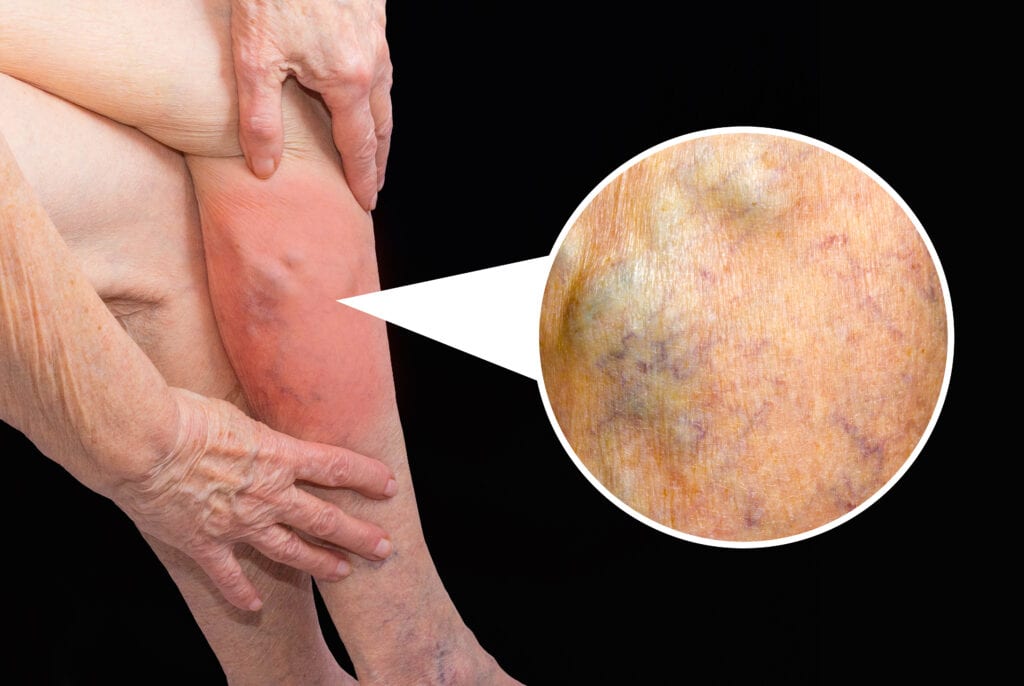Superficial venous thrombosis (SVT) is a varicose vein complication that can cause pain and tenderness.
Correctly diagnosing and monitoring the condition is important to prevent other—potentially life-threatening—issues. Since up to 80% of SVT patients have varicose veins, it’s important to know the symptoms.
What is Superficial Vein Thrombosis?
When a person has SVT, they have a blood clot in a vein near the skin’s surface, usually in an arm or leg. A firm lump develops under the skin and the area becomes red and painful. Although most people with varicose veins don’t develop SVT, SVT is typically a result of varicose veins.
When diagnosed with SVT, about 30% of patients find out they also have deep vein thrombosis (DVT). In addition, recent studies suggest that about 5% also have a pulmonary embolism (PE). Getting properly diagnosed for SVT means that your doctor can check for the associated life-threatening complications.
If SVT reoccurs in different locations in the body, it’s called migratory thrombophlebitis and can be indicative of cancer of an internal organ (Trousseau syndrome).
Besides having varicose veins, you are more at risk for SVT if you:
- Are inactive
- Are obese
- Have had a recent injury or surgery
- Have active cancer
- Have a personal or family history of venous thromboembolism (VTE)
- Are pregnant or are undergoing hormonal therapy
Symptoms of Superficial Vein Thrombosis

Superficial vein thrombosis can develop rapidly out of the blue. If you’re experiencing the following symptoms in an area, you should see a doctor at Canada Vein Clinics, who can determine if it’s SVT:
- Pain
- Swelling
- Red, warm or tender skin over the affected vein
- Affected vein feels like a firm cord, rather than a normal varicose vein
If a patient has SVT above the knee that’s not near a varicose vein, the doctor may recommend an ultrasound to check for clots in the deep veins. However, it can usually be diagnosed visually, without tests.
How to Prevent Superficial Vein Thrombosis
To prevent clots from enlarging, reoccurring or spreading to the deep veins, your Canada Vein Clinic doctor may recommend the following:
- Wearing compression stockings
- Frequently elevating your leg
- Taking oral over-the-counter nonsteroidal anti-inflammatory drugs (NSAIDs), such as ibuprofen or naproxen
- Preventing long periods of inactivity (sitting, standing or lying down)
Canada Vein Clinics specializes in the correction and treatment of venous insufficiency. Take the first step to better vein health by booking a consultation today.
Superficial Vein Thrombosis Treatment
Unlike DVT, which requires immediate medical attention, SVT usually subsides without treatment. Typically, the inflammation is reduced within a few days, but lumps may remain for a few more weeks. If you’ve already been diagnosed with SVT and the doctor has recommended home treatment, here are some of your options*:
- Warm or cold compresses
- Oral NSAIDs
- Topical NSAIDs (such as topical diclofenac)
- Prescription-strength compression stockings
*If you’re pregnant, check with your doctor about safe home treatment options.
Doctors may also provide quick relief by removing the thrombus and directing you to wear a compression bandage for a few days. In more severe cases, a patient may be given medication to prevent additional clotting.


